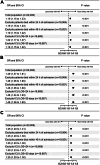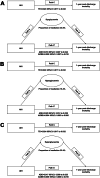The association between acute kidney injury and dysglycaemia in critically ill patients with and without diabetes mellitus: a retrospective single-center study
- PMID: 39230066
- PMCID: PMC11376290
- DOI: 10.1080/0886022X.2024.2397555
The association between acute kidney injury and dysglycaemia in critically ill patients with and without diabetes mellitus: a retrospective single-center study
Abstract
Background: Critically ill patients in the intensive care unit (ICU) often experience dysglycaemia. However, studies investigating the link between acute kidney injury (AKI) and dysglycaemia, especially in those with and without diabetes mellitus (DM), are limited.
Methods: We used the Medical Information Mart for Intensive Care IV database to investigate the association between AKI within 7 days of admission and subsequent dysglycaemia. The primary outcome was the occurrence of dysglycaemia (both hypoglycemia and hyperglycemia) after 7 days of ICU admission. Logistic regression analyzed the relationship between AKI and dysglycaemia, while a Cox proportional hazards model estimated the long-term mortality risk linked to the AKI combined with dysglycaemia.
Results: A cohort of 20,008 critically ill patients were included. The AKI group demonstrated a higher prevalence of dysglycaemia, compared to the non-AKI group. AKI patients had an increased risk of dysglycaemia (adjusted odds ratio [aOR] 1.53, 95% confidence interval [CI] 1.41-1.65), hypoglycemia (aOR 1.56, 95% CI 1.41-1.73), and hyperglycemia (aOR 1.53, 95% CI 1.41-1.66). In subgroup analysis, compared to DM patients, AKI showed higher risk of dysglycaemia in non-DM patients (aOR: 1.93 vs. 1.33, Pint<0.01). Additionally, the AKI with dysglycaemia group exhibited a higher risk of long-term mortality compared to the non-AKI without dysglycaemia group. Dysglycaemia also mediated the relationship between AKI and long-term mortality.
Conclusion: AKI was associated with a higher risk of dysglycaemia, especially in non-DM patients, and the combination of AKI and dysglycaemia was linked to higher long-term mortality. Further research is needed to develop optimal glycemic control strategies for AKI patients.
Keywords: Acute kidney injury; diabetes mellitus; dysglycaemia; hyperglycemia; hypoglycemia; long-term mortality.
Conflict of interest statement
No potential conflict of interest was reported by the author(s).
Figures






Similar articles
-
Stress hyperglycemia ratio as a predictor of acute kidney injury and its outcomes in critically ill patients.Ren Fail. 2025 Dec;47(1):2499228. doi: 10.1080/0886022X.2025.2499228. Epub 2025 May 5. Ren Fail. 2025. PMID: 40321025 Free PMC article.
-
Stress hyperglycemia ratio as an independent predictor of acute kidney injury in critically ill patients with acute myocardial infarction: a retrospective U.S. cohort study.Ren Fail. 2025 Dec;47(1):2471018. doi: 10.1080/0886022X.2025.2471018. Epub 2025 Feb 26. Ren Fail. 2025. PMID: 40012169 Free PMC article.
-
Hypoalbuminemia: a risk factor for acute kidney injury development and progression to chronic kidney disease in critically ill patients.Int Urol Nephrol. 2017 Feb;49(2):295-302. doi: 10.1007/s11255-016-1453-2. Epub 2016 Nov 5. Int Urol Nephrol. 2017. PMID: 27817055
-
Hyper/hypoglycemia and acute kidney injury in critically ill patients.Clin Nutr. 2016 Apr;35(2):317-321. doi: 10.1016/j.clnu.2015.04.006. Epub 2015 Apr 12. Clin Nutr. 2016. PMID: 25912231 Review.
-
Glucose control in the intensive care unit.Crit Care Med. 2009 May;37(5):1769-76. doi: 10.1097/CCM.0b013e3181a19ceb. Crit Care Med. 2009. PMID: 19325461 Review.
Cited by
-
Prognostic value of blood urea nitrogen to albumin ratio in septic patients with acute kidney injury-a retrospective study based on MIMIC database.Front Med (Lausanne). 2025 May 7;12:1510919. doi: 10.3389/fmed.2025.1510919. eCollection 2025. Front Med (Lausanne). 2025. PMID: 40400629 Free PMC article.
References
MeSH terms
Substances
LinkOut - more resources
Full Text Sources
Other Literature Sources
Medical
